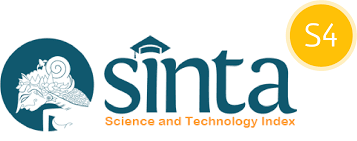Implementasi Algoritma K-Means dalam Analisis Klasterisasi Penyebaran Penyakit Hiv/Aids
DOI:
https://doi.org/10.29408/jit.v6i1.7423Keywords:
Clustering, Data Mining, HIV/AIDS, K-MeansAbstract
The most crucial component of everyone's life is their health, especially for young people, health problems that often arise in the younger generation are promiscuity or free sex. HIV/AIDS cases were reported in the last 30 years, from 1992 to 2022 as many as 2,052 were infected with HIV/AIDS. Dozens of them are students and college students. This study's objective was to cluster the total cases of HIV/AIDS based on sub-districts in Karawang district. Seeing which areas need more attention in dealing with cases of HIV/AIDS transmission and the areas with the highest cases can serve as a manual for choosing the highest areas and these areas can be the main focus. The approach adopted for this study is data mining. To solve the existing problems, the authors use the K-Means algorithm using 4 clusters to find out which sub-district groups have very high, high, medium and low numbers of HIV/AIDS cases by calcualating the centroid/mean of the cluster data. The results of the study contained 4 clusters as follows: cluster 0 with low criteria earned 73%, cluster 1 with very high criteria earned 3%, cluster 2 with medium criteria earned 7%, and cluster 3 with high criteria earned 17%.
References
L. Dempo, “Implementasi Data Mining Untuk Prediksi Penyebaran Virus Hiv / Aids Di Bandar Lampung,” J. Sist. …, vol. 3, no. 2, pp. 18–26, 2020, [Online]. Available: https://www.ejournal.lembahdempo.ac.id/index.php/SISKOMTI/article/view/120
R. W. Sari, H. Dedy, I. dan Gunawan, and W. P. Agus, “Aplikasi RapidMiner dalam Pengelompokkan Kasus Penyakit AIDS berdasarkan Provinsi dengan Data Mining K-means Clustering,” Reg. Dev. Ind. Heal. Sci. Technol. Art Life, pp. 59–69, 2018, [Online]. Available: https://ptki.ac.id/jurnal/index.php/readystar/article/viewFile/7/pdf (05 Juni 2020)
A. A. Lesmana et al., “Implementasi Algoritma K-Means Untuk Clustering Penyakit Hiv / Aids Di Indonesia Implementation of K-Means Algorithm for Clustering of Hiv / Aids Disease in Indonesia,” vol. 6, no. 2, pp. 5564–5580, 2019.
D. Y. Nugroho, A. Wibowo, F. Kesehatan, and M. Universitas, “ANALISIS CLUSTER K - MEANS KABUPATEN / KOTA DI JAWA TIMUR BERDASARKAN LEVEL EPIDEMIK HIV CLUSTER K - MEANS ANALYSIS OF THE HIV EPIDEMIC LEVEL IN,” vol. 8, no. 2, pp. 108–117, 2019, doi: 10.20473/jbk.v8i2.2019.108.
M. F. I. Al-Rizki, I. Widaningrum, and G. A. Buntoro, “Prediksi Penyebaran Penyakit TBC dengan Metode K-Means Clustering Menggunakan Aplikasi Rapidminer,” JTERA (Jurnal Teknol. Rekayasa), vol. 5, no. 1, p. 1, 2020, doi: 10.31544/jtera.v5.i1.2019.1-10.
W. Nengsih, “K-Means Analysis Klasterisasi Kasus HIV/AIDS di Indonesia,” J. Aksara Komput. Terap., no. February, 2017, [Online]. Available: https://jurnal.pcr.ac.id/index.php/jakt/article/view/1602
Suparyanto dan Rosad (2015, “済無No Title No Title No Title,” Suparyanto dan Rosad (2015, vol. 5, no. 3, pp. 248–253, 2020.
A. R. Jannah, D. Arifianto, and M. Kom, “Penerapan Metode Clustering dengan Algoritma K-Means untuk Prediksi Kelulusan Mahasiswa Jurusan Teknik Informatika di Universitas Muhammadiyah Jember,” J. Manaj. Sist. Inf. dan Teknol., vol. 1, no. 1210651237, pp. 1–10, 2015.
K. P. Sinaga, I. Hussain, and M. S. Yang, “Entropy K-Means Clustering with Feature Reduction under Unknown Number of Clusters,” IEEE Access, vol. 9, pp. 67736–67751, 2021, doi: 10.1109/ACCESS.2021.3077622.
A. Lia Hananto et al., “Analysis of Drug Data Mining with Clustering Technique Using K-Means Algorithm,” J. Phys. Conf. Ser., vol. 1908, no. 1, 2021, doi: 10.1088/1742-6596/1908/1/012024.
T. Tukino and B. Huda, “Penerapan Algoritma K-Means Untuk Mendukung Keputusan Dalam Pemilihan Tema Tugas Akhir Pada Prodi Sistem Informasi Universitas Buana Perjuangan Karawang.,” Techno Xplore J. Ilmu Komput. dan Teknol. Inf., vol. 4, no. 1, pp. 1–10, 2019, doi: 10.36805/technoxplore.v4i1.542.
V. Febriyanti, H. S. Tambunan, I. S. Saragih, and ..., “Implementasi Algoritma K-Means Dalam Pengelompokan Kasus Penyakit Tuberkulosis Paru Berdasarkan Provinsi,” Pros. Semin. Nas. Ris. Dan Inf. Sci., vol. 2, pp. 450–456, 2020, [Online]. Available: http://tunasbangsa.ac.id/seminar/index.php/senaris/article/view/194
H. Noor, A. Dharmawati, and T. W. Qur’ana, “Penerapan Algoritma K-Means Clustering Analysis Pada Kasus Penderita Hiv/Aids (Studi Kasus Kabupaten Banjar),” Technol. J. Ilm., vol. 12, no. 2, p. 72, 2021, doi: 10.31602/tji.v12i2.4573.
V. Ramadhan and A. Voutama, “Clustering Menggunakan Algoritma K-Means Pada Penyakit ISPA di Puskesmas Kabupaten Karawang,” J. Pendidik. dan Konseling, vol. 4, pp. 462–473, 2022.
Suhartini dan Ria Yuliani, “Penerapan Data Mining untuk Mengcluster Data Penduduk Miskin Menggunakan Algoritma KMeans di Dusun Bagik Endep Sukamulia Timur,” Vol. 4 No. 1, Januari 2021, Hal. 39-50, DOI : 10.29408/jit.v4i1.2986.
R. Kurniah, D. Y. S. Putra, dan E. Diana, “Penerapan Data Mining Decission Tree Algoritma C4.5 Untuk Mengetahui Tingkat Kepuasan Mahasiswa Terhadap Layanan Akademik Dan Kemahasiswaan (Studi Kasus Universitas.Prof.Dr. Hazairin,SH),” Vol. 5 No. 2, Juli 2022, Hal. 316-326, DOI : 10.29408/jit.v5i2.5910.
Downloads
Additional Files
Published
How to Cite
Issue
Section
License
Semua tulisan pada jurnal ini menjadi tanggung jawab penuh penulis. Jurnal Infotek memberikan akses terbuka terhadap siapapun agar informasi dan temuan pada artikel tersebut bermanfaat bagi semua orang. Jurnal Infotek ini dapat diakses dan diunduh secara gratis, tanpa dipungut biaya sesuai dengan lisense creative commons yang digunakan.
Jurnal Infotek is licensed under a Creative Commons Attribution 4.0 International License.
Statistik Pengunjung




